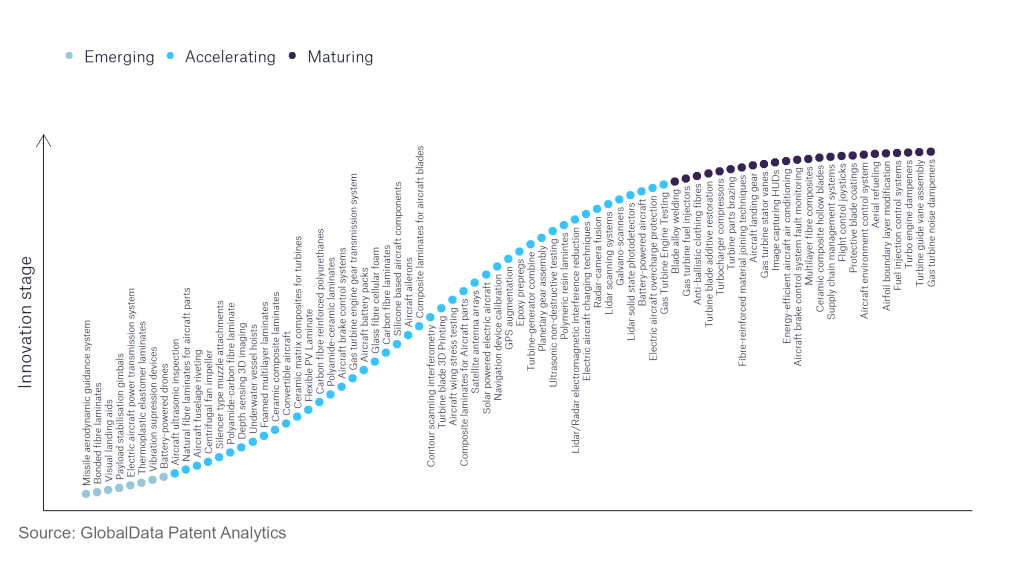The aerospace and defence industry continues to be a hotbed of innovation, with activity driven by the uptake of advanced technology, and growing importance of technologies such as hypersonics and advanced materials. In the last three years alone, there have been over 174,000 patents filed and granted in the aerospace and defence industry, according to GlobalData’s report on Environment Sustainability in Aerospace, Defence & Security: Aircraft powertrain control. Buy the report here.
However, not all innovations are equal and nor do they follow a constant upward trend. Instead, their evolution takes the form of an S-shaped curve that reflects their typical lifecycle from early emergence to accelerating adoption, before finally stabilising and reaching maturity.
Identifying where a particular innovation is on this journey, especially those that are in the emerging and accelerating stages, is essential for understanding their current level of adoption and the likely future trajectory and impact they will have.
180+ innovations will shape the aerospace and defence industry
According to GlobalData’s Technology Foresights, which plots the S-curve for the aerospace and defence industry using innovation intensity models built on over 262,000 patents, there are 180+ innovation areas that will shape the future of the industry.
Within the emerging innovation stage, bonded fibre laminates, thermoplastic elastomer laminates, and vibration supression devices are disruptive technologies that are in the early stages of application and should be tracked closely. Centrifugal fan impellers, ceramic composite laminates, and gas turbine engine testing are some of the accelerating innovation areas, where adoption has been steadily increasing. Among maturing innovation areas are protective blade coatings and blade alloy welding, which are now well established in the industry.
Innovation S-curve for the aerospace and defence industry

Aircraft powertrain control is a key innovation area in aerospace and defence
Aircraft powertrain control refers to control of the aircraft power train which converts the linear motion of the pistons into rotational motion of the crankshaft. There are three main parts to the power train; the crankshaft, the pistons, and the cylinders.
The aircraft powertrain describes the entirety of aircraft propulsion systems, including engines, transmissions, and propulsive elements. Control over the powertrain is an essential element of aircraft, allowing the pilot to control the aircraft’s speed and velocity.
GlobalData’s analysis also uncovers the companies at the forefront of each innovation area and assesses the potential reach and impact of their patenting activity across different applications and geographies. According to GlobalData, there are 20 companies, spanning technology vendors, established aerospace and defence companies, and up-and-coming start-ups engaged in the development and application of aircraft powertrain control.
Key players in aircraft powertrain control – a disruptive innovation in the aerospace and defence industry
‘Application diversity’ measures the number of different applications identified for each relevant patent and broadly splits companies into either ‘niche’ or ‘diversified’ innovators.
‘Geographic reach’ refers to the number of different countries each relevant patent is registered in and reflects the breadth of geographic application intended, ranging from ‘global’ to ‘local’.
Patent volumes related to aircraft powertrain control
Source: GlobalData Patent Analytics
Rolls-Royce is one of the leading patent filers in aircraft powertrain control amongst aerospace and defence companies. The firm is heavily involved in the production of propulsion systems for aircraft, producing a range of engines for both defence and commercial use. The company’s portfolio products include the Trent turbofan engine family which has been deployed on leading aircraft such as the A330, A340, A350, A380, Boeing 777, and Boeing 787 Dreamliner. Its defence offerings include EJ200 which is installed on the Eurofighter Typhoon, and M250 Turboprop installed on a number of defence rotorcraft platforms. Some other key patent filers include Boeing and Airbus, both leading commercial and defence aircraft primes.
In terms of application diversity, Rolls-Royce leads the way, whilst Boeing and Airbus come in at second and third, respectively. Regarding geographic reach, Rolls-Royce holds the top spot, followed by Wisk Aero and Boeing.
An aircraft’s powertrain is one of its most essential components, generating power, typically from chemical fuels, and transmitting this power to propulsive elements in order to provide the aircraft with thrust. Going forward, control over aircraft powertrains will remain an essential product for aircraft producers, and it is likely that novel technologies will be incorporated to increase efficiency and enhance the sustainability performance of aircraft.
To further understand the key themes and technologies disrupting the aerospace and defence industry, access GlobalData’s latest thematic research report on Defence.
Data Insights
From

The gold standard of business intelligence.
Blending expert knowledge with cutting-edge technology, GlobalData’s unrivalled proprietary data will enable you to decode what’s happening in your market. You can make better informed decisions and gain a future-proof advantage over your competitors.



